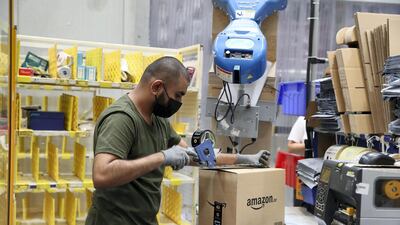It is likely that we have all ordered from Amazon at least once or twice. Since the US e-commerce site launched in the UAE in May 2019, with Amazon Prime coming a month later, it has become a convenient go-to, with next-day and same-day delivery.
But just how does an operation as giant as Amazon work? We took a look inside its largest fulfilment centre in the UAE, stocked with more than 4 million products, spread over 32,700 square metres with more than 650 staff members, to find out.
Modern Willy Wonka
Touring the DXB3 centre, in Dubai Logistics City, we felt like we had been shown behind the curtain of a top-secret space, with an almost Charlie and the Chocolate Factory-level of intrigue.
The well-oiled machine is as you'd expect – noisy, fast-paced and vast, but also incredibly slick. To the untrained eye, there does not seem to be an idle hand (or pair of feet) on the floor.
It is expansive, with seemingly endless shelving, branded boxes as far as the eye can see, and carousels spiralling crates down from upper levels of the centre to the ground floor.
Touring the Amazon fulfilment centre
In the US, Canada and at various sites in Europe, members of the public could take tours of Amazon's fulfilment centres, giving customers a chance to see what happens after they click "Buy Now", as well as working conditions within the spaces. However, these are on pause during the Covid-19 pandemic.
Prashant Saran, director of operations for Amazon Mena, does not rule this kind of transparency out for the Dubai fulfilment centres.
"Given Covid-19 right now, of course there are restrictions. We try to keep safety first, but that is definitely something we want to enable in this region," Saran told The National following our tour.
Process of an Amazon package
We were given a detailed breakdown of the journey of a package by Geoffrey Khalil, the inbound operations manager. In a nutshell, everything coming into the fulfilment centre, and the people working with that inventory, fall under his remit.
"Everything at the fulfilment centre is enabled by the wonderful people that work for us; they are some of the most customer-obsessed people on the planet," Saran explains. "And through technology, which is the secret sauce, it enables the whole process."
From the moment items are received at the centre and added to the site's inventory physically as well as virtually, they can be bought by customers.
The items are then stowed away on shelves. Interestingly, there is no strict system that dictates exactly where a product is stored. A system of barcodes guide staff to where products are found, but you won't find a row of pet food, followed by a row of beauty products and children's toys – it is not set up like a library or supermarket.
The Amazon term for collecting items for orders is "picking", the process during which staff members walk among the shelves and select items as indicated on their scanners. They shout "corner" before turning around bends as a health and safety precaution with or without a trolley; it's a call that becomes a soundtrack to the day.
Orders, or parts of orders, are batched in yellow crates, and then separated into complete orders, a process they call "rebinning". When a staff member is picking, they are not necessarily working on one single order or even whole orders – they're broken up by an AI system that assigns orders to be collected in the most time-efficient manner.
When orders are regrouped and ready to go to the customer, they are scanned and packed, but remain unlabelled.
Then comes the "slam" process. Slam is an acronym, which stands for Scan, Label, Apply and Manifest. The technology at this station scans the box and, based on the weight, immediately knows to print the correct shipping label on the box.
From there, the item leaves the building and is shipped off to the customer.
Covid-19 and Amazon
It is no secret that Amazon as a whole has benefited from the Covid-19 pandemic. A time when people could not leave their houses made a company that would bring shopping to their doors – be it essential or luxury buys – almost indispensable. Its 2020 sales surged 38 per cent to $386.1 billion from a year earlier, according to figures released by the company in February.
Saran plays this down, saying that "the onset of the pandemic was a challenging time for all of us". However, he is clear that the company's primary focus was introducing safety measures that would allow them to continue to function.

"As we [at Amazon] started to come to terms with this new reality, we were absolutely clear that our topmost priority was safety. We had to make sure we put in place robust mechanisms, including technology innovations, process changes and training, to make sure that people are safe."
Walking around the centre there are clear processes. There is an AI camera system that sounds an alarm if people are walking within two metres of each other, tables in the lunchroom are amply spaced out and there are screens between the stationary workspaces, as well as mandatory face masks and hand sanitiser dispensers, which have been installed throughout the centre.
The company claims to have invested $11.5 billion on more than 150 processes related to Covid-19.


















